9 Nights 10 Days
Daily Tour
50 people
___
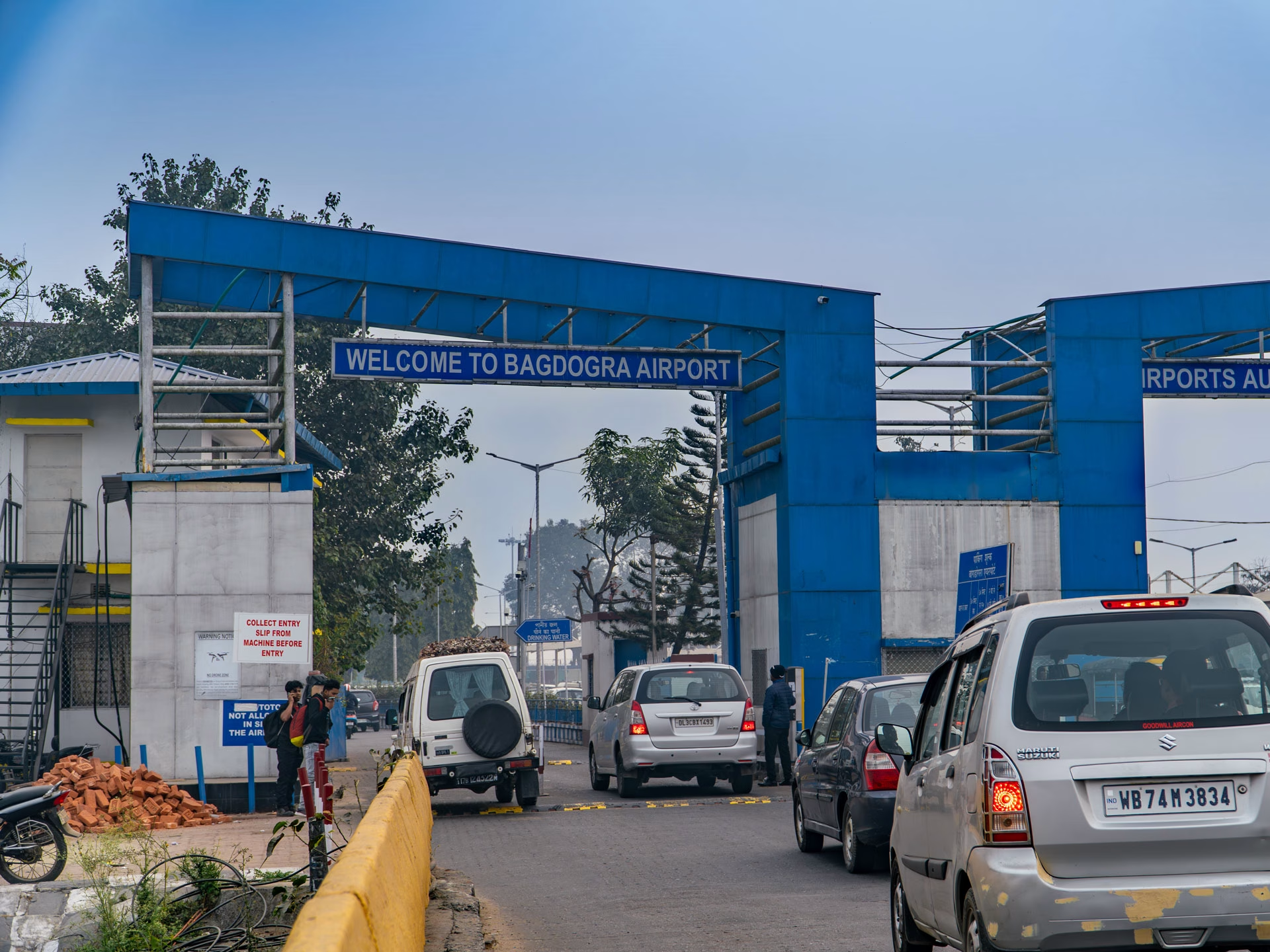
Upon arrival at Bagdogra Airport (IXB) or New Jalpaiguri Railway Station (NJP), you will be greeted by our representative and transferred to Gangtok. Enjoy a brief stop at Triveni View Point, where the Teesta and Rangeet rivers converge. Continue your scenic drive through winding roads alongside the Teesta River. Explore MG Marg at your leisure in the evening before checking into your hotel for an overnight stay in Gangtok.
Meals: Dinner
Night: Stay at the Hotel at Gangtok
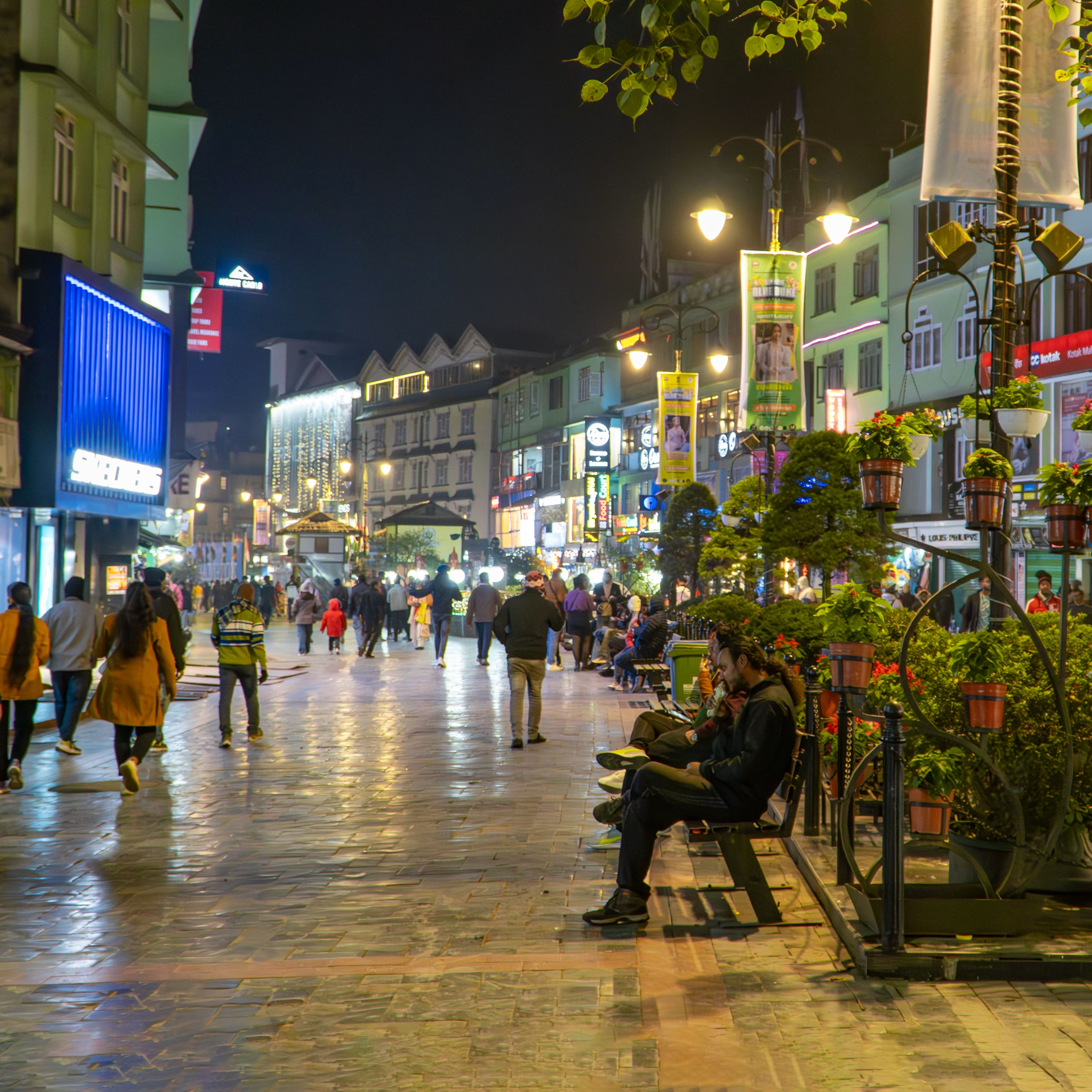
After breakfast, embark on a full-day excursion around Gangtok. Start by visiting the picturesque Tsomgo Lake, renowned for its changing colours. Then, continue to Baba Mandir, a tribute to Indian Army soldier Baba Harbhajan Singh. For those interested, hire a taxi to visit Nathula Pass, the Indo-China border post (subject to availability and extra cost). Return to Gangtok for an overnight stay.
Meals: Breakfast & Dinner
Night: Stay at the Hotel at Gangtok
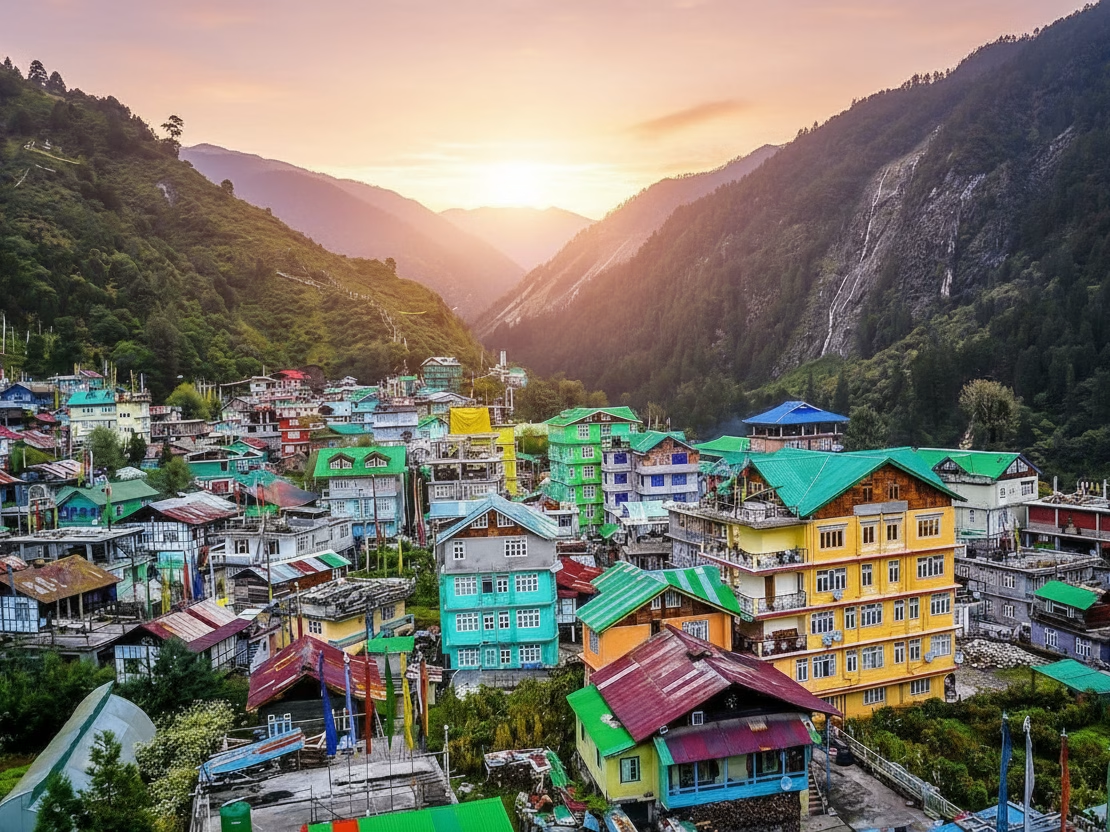
After breakfast, you'll drive 125 km to Lachen, stopping at Naga Falls and passing through Chungthang Village. You'll continue via Kanchenjunga National Park before arriving in Lachen for an overnight stay.
Meals: Breakfast & Dinner
Night: Stay at the Hotel at Lachen
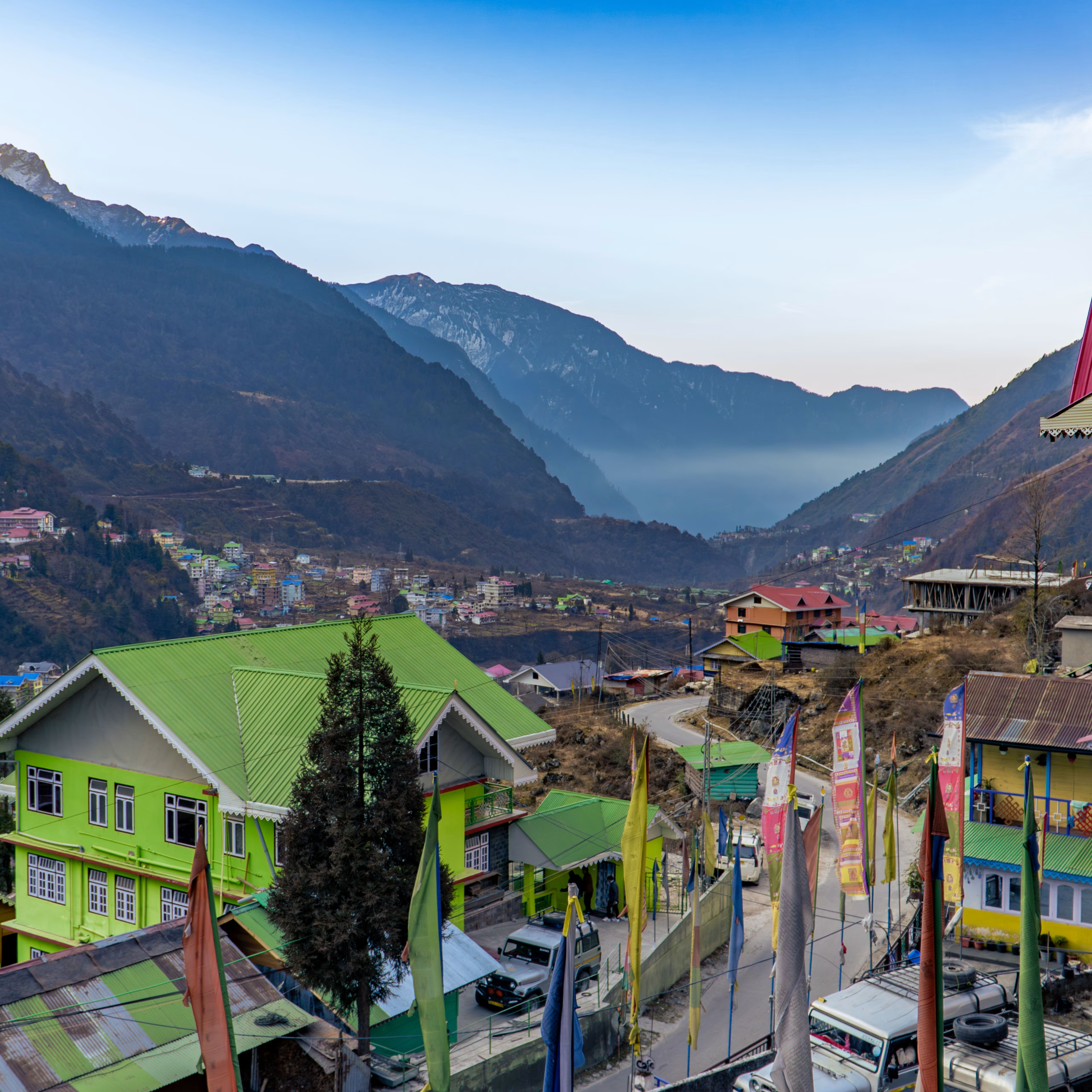
Start your day with breakfast before heading north to visit Gurudongmar Lake, one of India's highest lakes. En route, pass through Thangu Village, a remote Tibetan nomad settlement. After enjoying the scenic views of the lake, continue your journey to Lachung, stopping for lunch along the way. Arrive in Lachung by evening, check in, and unwind with an overnight stay.
Meals: Breakfast & Dinner
Night: Stay at the Hotel at Lachung
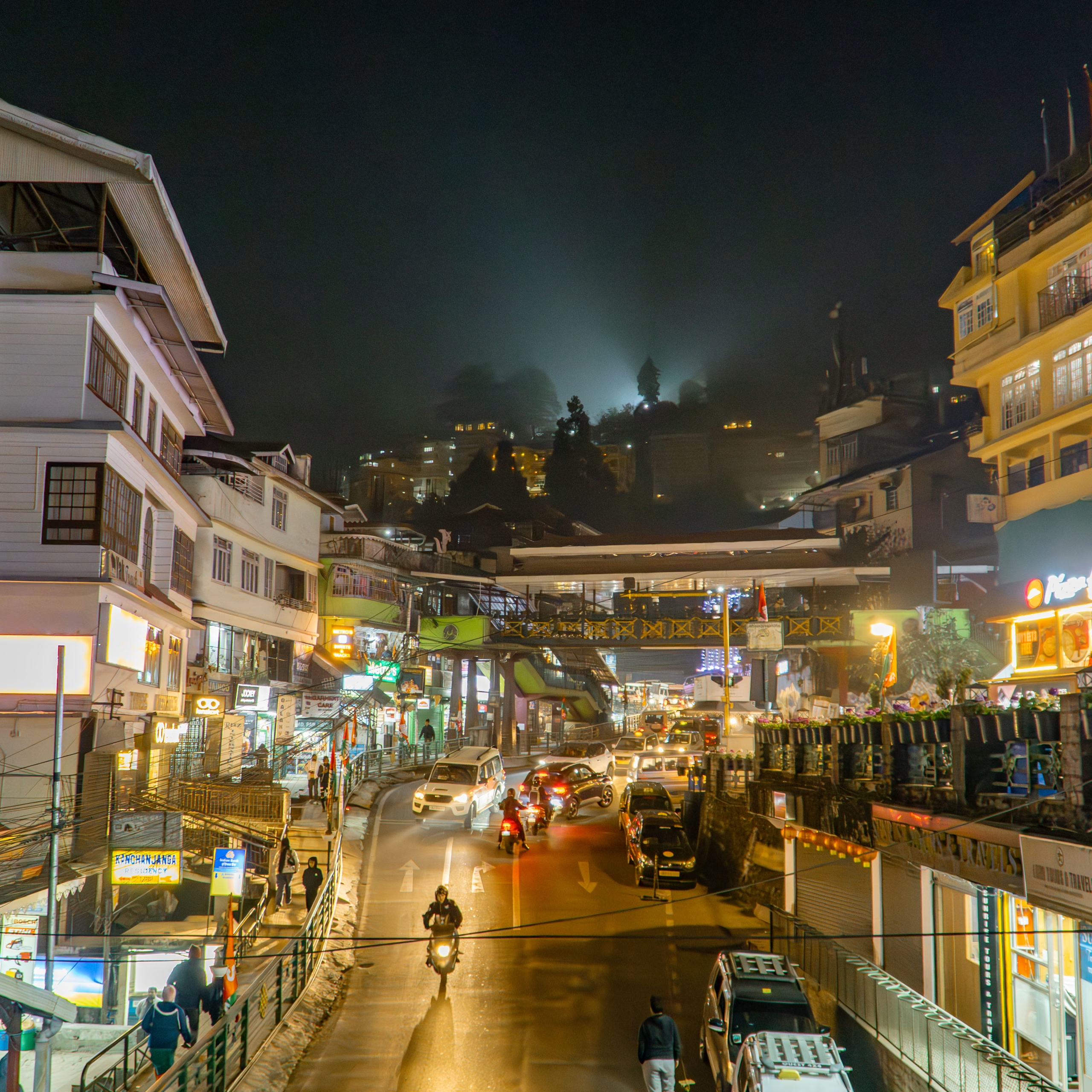
After breakfast, you'll head north from Lachung to visit Yumthang Valley, known as "the valley of flowers" and "the Switzerland of North East" for its stunning beauty. You'll explore the Singba Rhododendron Sanctuary within the valley and visit Zero Point, the last outpost of civilisation. After sightseeing, you'll drive back to Gangtok to check in for an overnight stay.
Meals: Breakfast & Dinner
Night: Stay at the Hotel at Gangtok
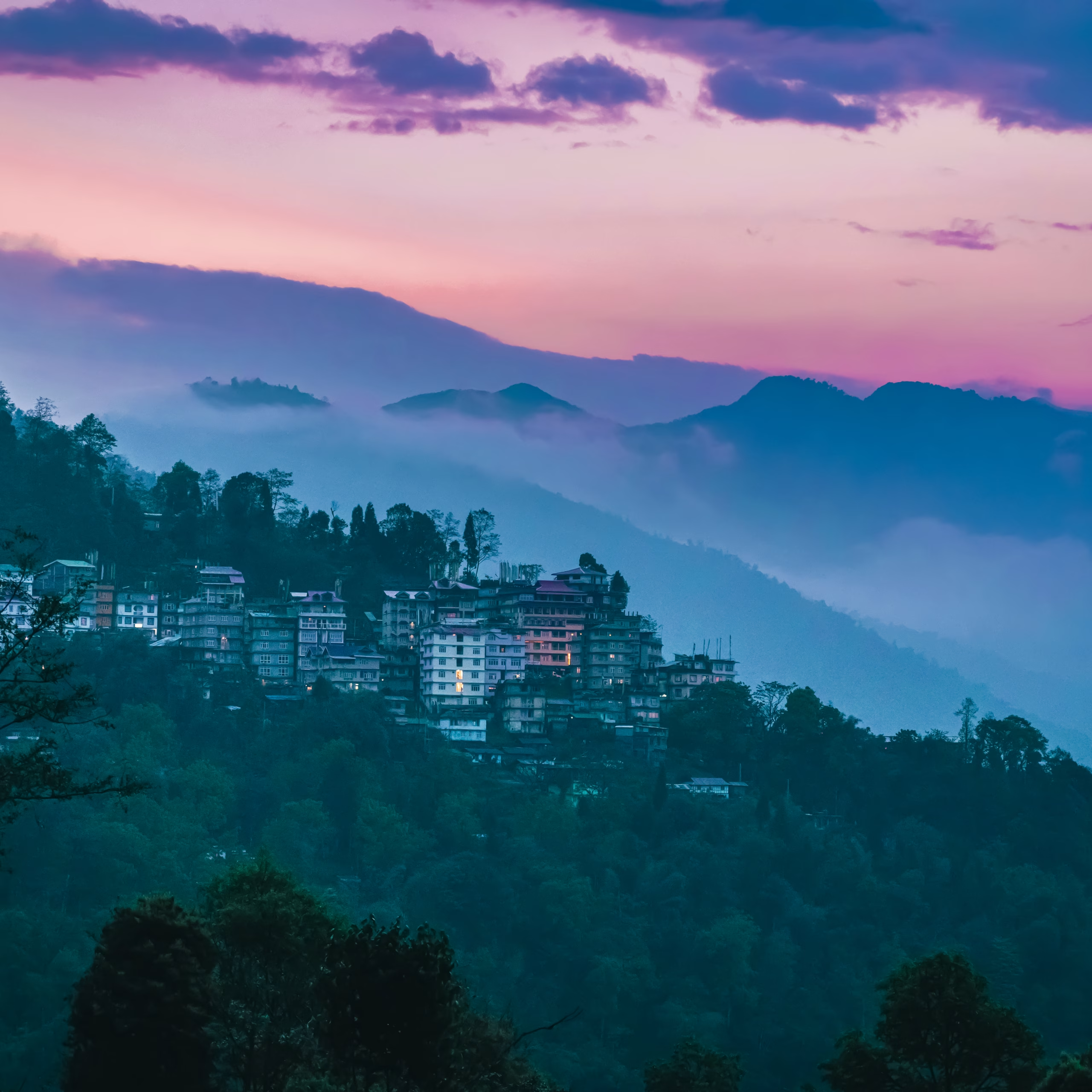
After breakfast at the hotel, you'll transfer to Pelling in West Sikkim. En route, you'll stop at either Ravangla or Namchi. In Ravangla, visit Buddha Park, featuring a 130 ft. Shakyamuni Buddha statue amidst picturesque gardens and Himalayan views. If taking the Namchi route, explore the Namchi Chardham Complex, home to a 108 ft. Lord Shiva statue surrounded by Chardham replicas. Continue your scenic journey with views of the Kanchenjunga Ranges, arriving in Pelling for an overnight hotel stay.
Meals: Breakfast & Dinner
Night: Stay at the Hotel at Pelling
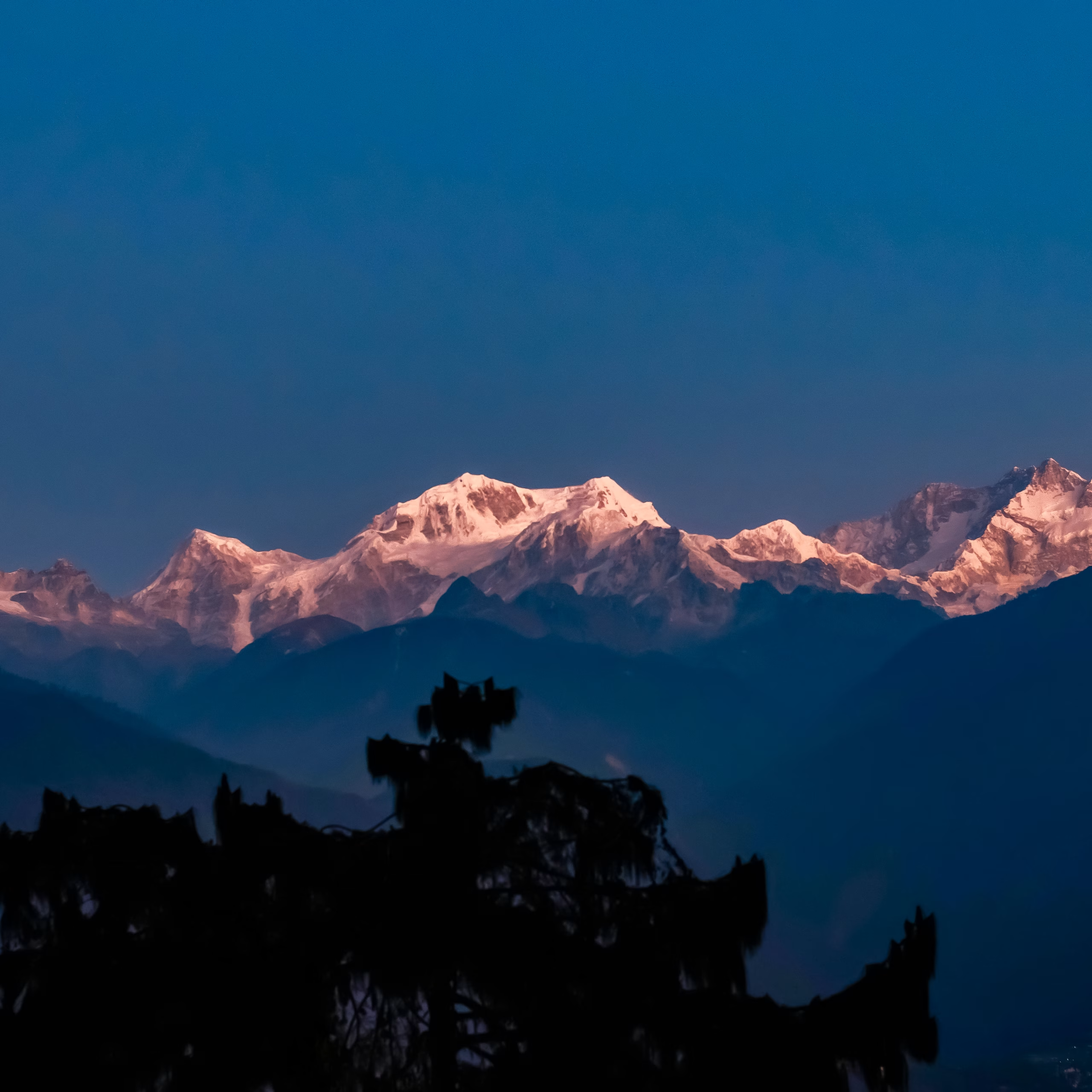
After breakfast at the hotel, you'll explore Pelling and visit Khecheopalri Lake, the wish-fulfilling lake. You'll then see the scenic Rimbi Waterfalls and take a peaceful stroll through the Rimbi Orange Garden. Next, you'll explore Darap Village to connect with nature, followed by a visit to India's highest Skywalk, featuring a 137-foot Chenrezig statue. You'll continue to the historic Rabdentse Ruins and end the day's sightseeing at the Pemayangtse Monastery. Return to your hotel in Pelling for an overnight stay.
Meals: Breakfast & Dinner
Night: Stay at the Hotel at Pelling
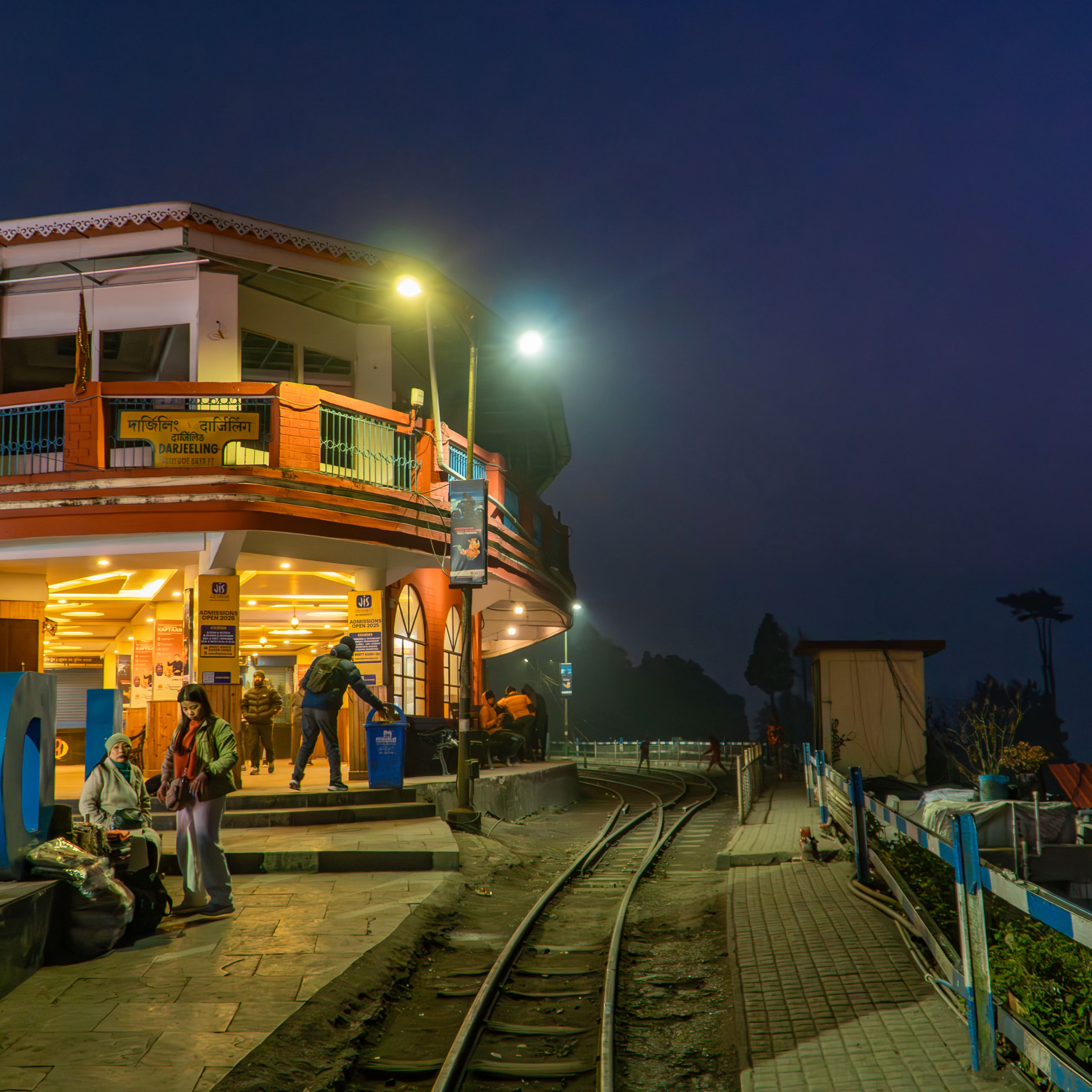
After breakfast at the hotel, you'll transfer to Darjeeling, a picturesque hill station. Enjoy the scenic drive. As you approach Darjeeling, you'll be greeted by the fragrant tea plantations lining the streets. On arrival, check-in at your hotel and enjoy an overnight stay.
Meals: Breakfast & Dinner
Night: Stay at the Hotel at Darjeeling
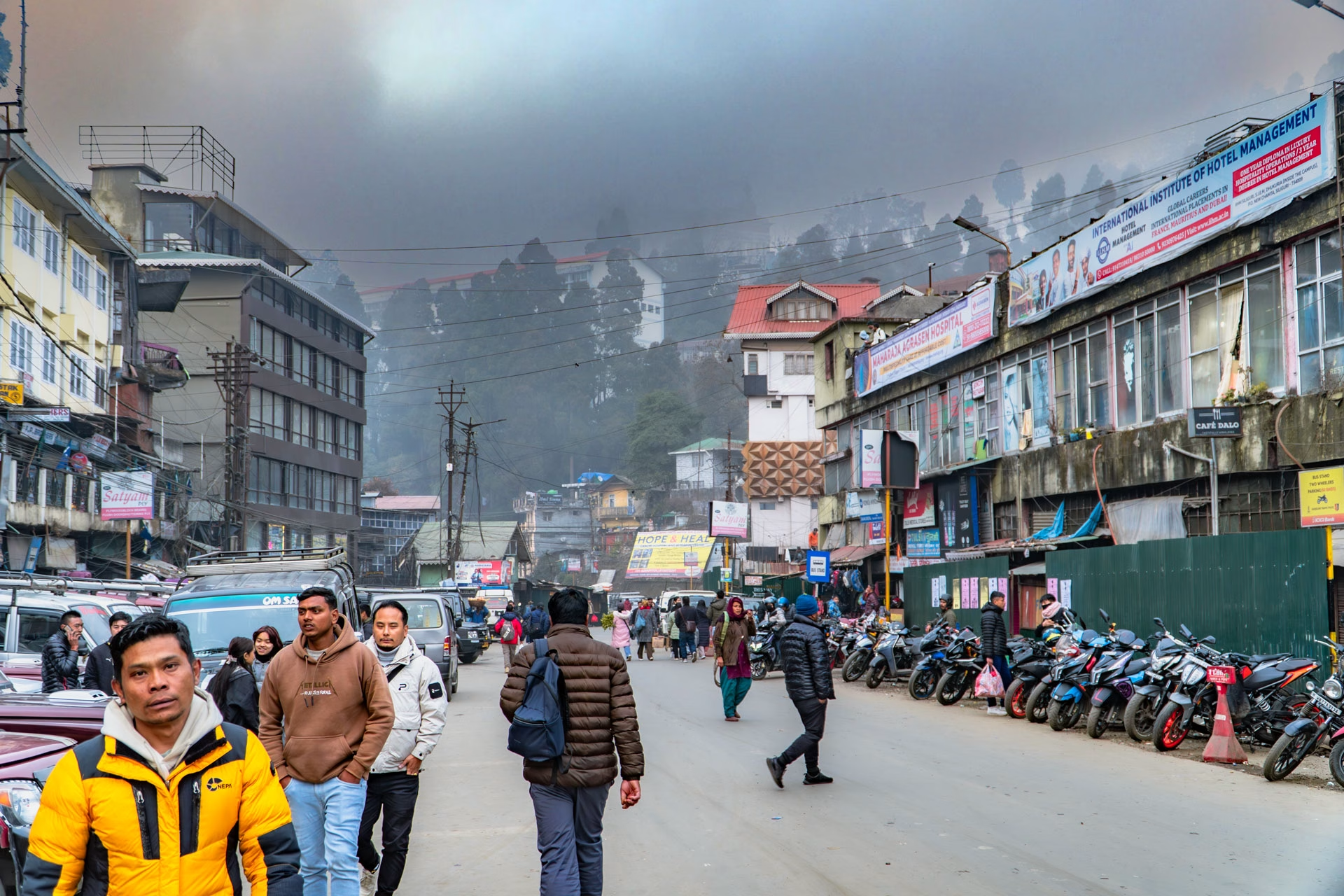
Start your day early at 4 AM with a visit to Tiger Hill to witness the stunning sunrise over Mt. Kanchenjunga. Return to the hotel for breakfast before enjoying a UNESCO-listed toy train ride from Darjeeling to Ghum Station and back via the Batasia Loop, offering panoramic views and a stop at the Gorkha Regiment Memorial. Continue to the Himalayan Mountaineering Institute and Padmaja Naidu Himalayan Zoological Park to explore mountaineering history and see Himalayan wildlife, including the endangered Red Panda. Enjoy a ropeway ride over tea plantations, then visit the Japanese Temple and Peace Pagoda for a peaceful meditation before returning to the hotel for an overnight stay.
Meals: Breakfast & Dinner
Night: Stay at the Hotel at Darjeeling
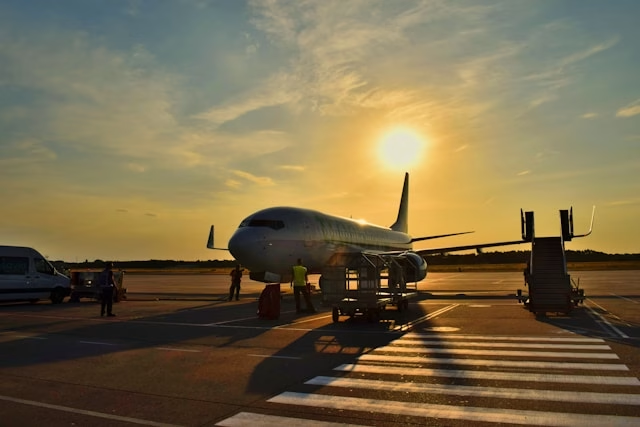
Wake up to a lovely morning in Darjeeling and enjoy breakfast at the hotel. Afterwards, transfer to Bagdogra Airport (IXB) or New Jalpaiguri Railway Station (NJP). Your tour concludes as you depart for your onward journey, bringing home wonderful memories of your trip.
Meals: Breakfast
Night: Nil
| Location | Places to visit |
| Gangtok | Triveni View Point, Tsomgo Lake, Nathula Pass, Baba Mandir, Kanchenjunga and Siniolchu Peaks, Ganesh Tok and Hanuman Tok Temples, Ban Jhankri Falls |
| Lachen | Naga Falls, Chungthang Village, etc. |
| Lachung | Gurudongmar Lake, Thangu Village, Yumthang Valley, Singba Rhododendron Sanctuary, Zero Point, etc. |
| Pelling | Khecheopalri Lake, Rimbi Waterfalls, Sikkim Skywalk, Pemayangtse Monastery |
| Darjeeling | Tiger Hill, Gorkha Regiment Memorial, Himalayan Mountaineering Institute and Padmaja Naidu Himalayan Zoological Park |
Note:
Unexpected events or government restrictions may cancel the tour. In such cases, you can reschedule your dates. However, we will not provide a refund.
The booking amount (30% of the package amount) is non-refundable. However, you can adjust this amount with any other tour, trek, or activity Uncia offers after the booking date.
For a lifetime journey to Sikkim, the hidden Himalayan gem in northeastern India. For 10 days, you will step into Gangtok, the state capital, to experience the hustle and bustle of city life with crowded streets, colourful markets, and excellent viewpoints of panoramic views of the alluring mountains surrounding it. Visit MG Marg, the shopping and dining hub and Banjhakri Falls. Then, move to the serene towns of Lachen and Lachung, where you’ll be surrounded by nature. In Lache, discover the stunning Gurudongmar Lake amidst the towering peaks, alpine meadows, and lakes of Thangu Valley. In Lachung, you’ll be mesmerised by Yumthang Valley, known as the “Valley of Flowers”, where rhododendrons bloom. Moving south, you’ll reach Pelling, a quiet town where you can see the majestic Kanchenjunga Range from the Pelling Skywalk. Explore the historic Rabdentse Ruins, 17th-century Pemayangtse Monastery, the fulfilling Khecheopalri Lake and the mesmerising Rimbi Waterfalls. Your journey ends in Darjeeling, a charming hill station with tea gardens and views. Wake up early to see the sunrise over the snow-capped Kanchenjunga from Tiger Hill, take a fun ride on the Darjeeling Himalayan Railway (Toy Train), and stroll through the markets on Mall Road. Visit the Himalayan Mountaineering Institute to see the mountaineering history and artefacts from famous expeditions. Darjeeling is the perfect blend of nature, culture and nostalgia, and it reminds you of iconic Bollywood movies like Barfi and Main Hoon Na.
Pelling: The Essence of Sikkim
Pelling, located in West Sikkim, India, is famous for its incredible view of Kanchenjunga, the third-highest mountain in the world. At an altitude of 2,150m (7,050ft), Pelling gives the flavour of Sikkim with its lush green landscapes, cascading waterfalls, and rich cultural heritage.
Natural Splendor: Some say it is the most beautiful place because of its dominating views of Mt. Kanchenjunga. Pelling has an ethereal quality created by the puffs of mist and ribbons of cloud that often envelop its scenery. Picturesque valleys and winding rivers make this locality one of the ideal places for trekking, mountain biking, and watching birds. Although included on the UNESCO World Heritage Site list, Khangchendzonga National Park is a real treasure for biodiversity. It gives nature enthusiasts a chance to have a rare glimpse of the ecological wealth of this area.
Cultural Heritage: Sikkim is a town deeply struck by cultural history, interspersed with Tibetan Buddhism, Nepali customs, and Indigenous traditions. It has ancient monasteries, gompas, and stupas that serve as spiritual sanctuaries. Sikkim’s oldest and most revered monastic institution, the Sangachoeling Monastery, is a place of great significance, with many rare artefacts and holy relics. The Sangachoeling Monastery stands at a higher altitude, granting sweeping views and a peaceful setting for meditation and contemplation.
Adventure and Exploration: Adventurous spirits, Pelling is all about electrifying adventures with nature in full view. Yuksom Valley is a hot trekking spot, with trails crossing its lakes and lush alpine meadows, moving through high mountain passes. The venerated Khecheopalri Lake is called the “Wishing Lake” because it is supposed to be blessed with sacred healing and purification powers. Rimbi Waterfall and Kanchenjunga Falls are alluring picnic spots, ideal for photography and relaxation while soothingly gurgling water amalgamations.
Spiritual Sanctuaries: Pelling is a place for seekers or pilgrims searching for inner peace and enlightenment. Tashiding Monastery in the lush hills of West Sikkim is a renowned site associated with Guru Padmasambhava, the patron saint of Sikkim. The annual Bumchu festival at Tashiding Monastery provides a colourful display of faith, where devotees take part in sacred rituals. Nearby Rabdentse Ruins offer a glimpse into the royal splendour of the erstwhile capital of Sikkim through its palaces and temples.
Community and Hospitality: The Pellyhill is renowned for its warm hospitality and vibrancy of local life. The locals warmly welcome visitors, and markets, teahouses, and eateries from Pelling showcase local dishes, such as momos, thukpa, and yak-butter tea. The Pang Lhabsol festival is an event in which local music, dance, and other performances depict the cultural diversity of Sikkim.
Lachen
Lachen, located in northern Sikkim, India, is a hidden gem offering breathtaking natural beauty. Situated at 8,838 feet along the North Sikkim Highway, this small village has recently become accessible to tourists. The area is surrounded by lush landscapes and dramatic ravines, with multi-coloured mountains, snow-capped peaks, and towering cliffs rising from the land.
The settlement is sparsely populated, but basic accommodations are available for visitors to enjoy a comfortable stay. Lachen is home to a monastery that caters to the spiritual needs of the locals. It is also a popular starting point for trekking expeditions to Green Lake and the Kanchenjunga National Park. Visitors can trek to both Chopta Valley and Green Lake, although foreigners are restricted from visiting Gurudongmar Lake. Overall, Lachen is a captivating destination for those travelling to North Sikkim.
Sightseeing In Lachen
Chopta Valley
Chopta Valley is located at 13,200 ft in northern Sikkim. It’s a virgin place for nature lovers and adventure seekers. Trekking, hiking, angling, and bird watching are available here. A frozen lake is a winter attraction. Rich flora and fauna make it a wildlife-spotting paradise.
Thangu
Thangu is at 13,000 ft near Lachen. It’s a stopover for tourists going to Gurudongmar Lake. The lake is sacred for both Hindus and Buddhists. Thangu is near Cho Lhamu, the source of the Teesta River and has views of surrounding mountains and Lachen Monastery.
Gurudongmar Lake
Gurudongmar Lake is at 17,100 ft near the Chinese border. It’s known for its beauty and never-freezing portion. Accessible only to Indian citizens with permits. Surrounded by peaks and minor temples. A challenging but rewarding destination for adventure seekers.
Chungthang
Chungthang is at 5,600 feet where the Lachen and Lachung rivers meet. It’s famous for the sacred rock where Guru Rinpoche’s footprints are believed to be. The rock also has a small paddy field where paddy grows, a miracle attributed to the saint. Chungthang is the gateway to Lachung and Lachen.
Dzongu
Dzongu is a remote village in the Kanchenjunga Biosphere Reserve. It is home to the Indigenous Lepcha community. Surrounded by thick forests and scenic landscapes, Dzongu is perfect for high-altitude treks like the Tolung-Green Lake trek and offers a glimpse into the region’s untouched natural beauty.
Labrang Monastery
Built-in 1814, Labrang Monastery in northern Sikkim belongs to the Nyingmapa sect of Buddhism. It is dedicated to Latsun Chembo, a Tibetan Buddhist figure, and offers spectacular views of the forested mountains. It is a peaceful place for meditation and reflection.
Phensang Monastery
Located in northern Sikkim, Phensang Monastery is known for its annual Chaam dance performed by monks. Built in 1721, the monastery was rebuilt after a fire in 1947. It’s a sacred site for Buddhists and offers a breathtaking view of the surrounding hills.
Mangan
Mangan, the headquarters of North Sikkim, is an emerging tourist destination at 3,950 feet. Known for its scenic beauty and proximity to key attractions like Phensong and Phodong Monasteries, Mangan also offers a souvenir market and is a base for exploring the region.
Rong Lungten Lee
Rong Lungten Lee is a replica of a traditional Lepcha house in Namprikdang. Open year-round, it showcases artefacts and is surrounded by lush nature at the confluence of the Kanaka and Teesta rivers.
Singhik
Singhik, a small hamlet just 4 km from Mangan, is known for its breathtaking views of the Kanchenjunga range. The Singhik View Point offers panoramic vistas of the mountains and rivers, making it a perfect stop for travellers to Lachen or Lachung. Basic accommodation is available for tourists.
Lachung
Lachung, at an altitude of 9,600 feet in the North Sikkim district of Sikkim, is a delightful town that attracts travellers with its natural beauty. The city is located at the confluence of the Lachung and Lachen streams, tributaries of the Teesta River. It has numerous waterfalls and snow-capped peaks. The journey to Lachung passes through beautiful villages and landscapes, ideal for solitude seekers. It was recently developed for tourism and is tranquil and charming, often called a “Shangri-La.”
Lachung sightseeing
Yumthang
Valley of Flowers, Yumthang, is at an elevation of 11,800 feet and is a delight for nature lovers. Wildflowers, including primulas and rhododendrons, are rioted with colour during springtime. A major attraction is the Shingba Rhododendron Sanctuary, which has 24 species of rhododendrons. The area also features a lush green meadow, pine, and silver fir forests cascading nearby surging waterfalls and hot springs. Yumesamdong and Shiv Mandir are also places to visit in the vicinity, providing incredible vistas.
Hot Springs
Yumthang Hot Springs, situated at 12,000 feet, is essential for its sulphur content and alleged cure for yeast infections. This spring is just next to the Yumthang River and has a bath in a small hut, providing visitors with a therapeutic bath. It is in a restricted area, making it all the quieter and a natural healer.
Yumesamdong (Zero Point)
This point is situated at 15,300 feet near the border with
Katao
Katao Valley is located just 24 km from Lachung at over 15,000 feet and is known for its snow-capped peaks and rhododendron-covered valleys. The area remains ice-covered most of the year, offering a serene, wintry landscape perfect for those seeking solitude and spectacular views of the Himalayan range.
Darjeeling
The Queen of the Hills Darjeeling, in the Indian state of West Bengal. It is also renowned for its tea industry and the Darjeeling Himalayan Railway (DHR). UNESCO designated it a World Heritage site. It is especially famous for its majestic views of Mount Kanchenjunga. Here, one admires the wide Singalila range, including vistas of Bhutan’s Himalayas and even parts of the Everest range.
Key Attractions
Darjeeling Himalayan Railway (DHR)
The Darjeeling Himalayan Railway, affectionately known as the “Toy Train,” features a 2 ft (610 mm) narrow gauge railway stretching 86 kilometres (53 miles) between New Jalpaiguri and Darjeeling. Declared a UNESCO World Heritage site, the railway’s construction began in 1879 and was fully operational by 1881. Its elevation ranges from 100 meters (328 feet) at New Jalpaiguri to 2,200 meters (7,218 feet) at Darjeeling. A journey from Siliguri to Darjeeling, lasting approximately seven hours, or a joy ride within Darjeeling, offers an unforgettable experience.
Himalayan Mountaineering Institute (HMI)
Established in 1954 by Tenzing Norgay Sherpa following his historic Everest ascent in 1953, the Himalayan Mountaineering Institute is a premier institution for mountaineering training. Situated on Jawahar Parbat, about 2 kilometres from Chowrasta, the institute boasts a rich collection of mountaineering equipment and artefacts from various expeditions. The Everest Museum within the institute showcases attempts to conquer Mount Everest. Visitors can also view Himalayan peaks through a Zeiss Telescope, a gift from Hitler to the Nepalese Maharaja. Tenzing Norgay served as the institute’s Director for many years and was cremated nearby after he died in 1986.
Tiger Hill
Located 13 kilometres from Darjeeling at 2,590 meters (8,482 feet), Tiger Hill is renowned for its spectacular sunrise views over Kanchenjunga and the eastern Himalayan peaks. On clear days, visitors can even glimpse Mount Everest and other towering peaks such as Lhotse, Makalu, Rathong, Kabru, Simvo, and Siniolchu.
Kalimpong
Kalimpong is a tranquil hill station at an elevation east of the Teesta River. Known for its historical educational institutions established during British rule, Kalimpong was once a trade gateway between Tibet and India. The town is famous for its Indigenous handicrafts, including Tibetan and Bhutanese jewellery, woodcarvings, and copperware. Horticulture is a vital part of the local economy, with a notable flower market specialising in orchids and nurseries exporting Himalayan-grown bulbs and tubers. The Zang Dhok Palri Phodang monastery, home to rare Tibetan Buddhist scriptures, serves as a spiritual centre.
Lava & Loleygaon
Lava and Loleygaon are serene hamlets near Kalimpong, ideal for nature enthusiasts. Lava, located 32 kilometres from Kalimpong, is the entry point to the Neora Valley National Park. The scenic route to Lava features a transition from tropical deciduous forests to alpine vegetation. Loleygaon, 24 kilometres from Lava, is a small Lepcha village offering panoramic views of the Kanchenjunga range.
Sikkim is renowned for its breathtaking high-altitude lakes, such as Gurudongmar and Tsomgo, which feature crystal-clear waters set against a tranquil backdrop. Meanwhile, Darjeeling is famous for its expansive tea plantations, which blanket the lush hills and offer stunning panoramic views of the surrounding landscape.
March and June are the best time to visit Darjeeling. The weather is mild and pleasant during these months, providing perfect conditions for sightseeing and outdoor activities.
In addition to the Darjeeling Himalayan Railway Station (88 km from New Jalpaiguri Railway Station), the nearest railway stations are Siliguri and New Jalpaiguri. Both stations are well-connected by direct trains to major cities across India, including Kolkata, Delhi, Guwahati, and more.
Darjeeling is famous for its tea, known globally for its distinctive flavour. The region continues to produce tea using traditional methods, particularly the 'orthodox' process, which has been preserved since its beginnings.
Snowfall in Darjeeling is possible in December, although it is unpredictable and may not occur yearly. The best time to visit Darjeeling is between April and June, as the weather is most pleasant during these months. For those hoping to experience snowfall, the ideal time to visit is from October to January.
Day-wise Itinerary Details:
Uncia Trails' travel partners offer excellent tour packages within and outside India. We are passionate about travel and strive to develop meaningful experiences. Our experienced team of travellers will work with you to create the ideal getaway.
Leave a review